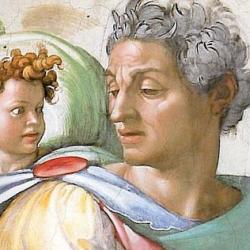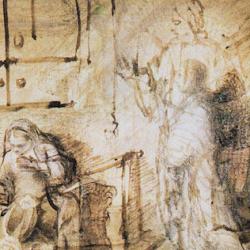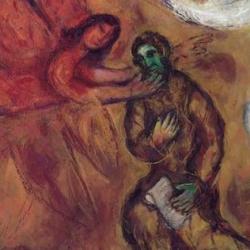My colleague Toby Sumpter suggests that Isaiah 22 ends with an image of the cross. Eliakim is compared to a peg on which hangs the glory of his father’s house, but the peg “gives way” and “breaks off” and is cut off. This is perhaps an image of the cross. The “burden” that is cut off is the burden of the judgment again Jerusalem (Toby points out that massa introduces the oracle in 22:1 and also ends the oracle).
That interpretation fits a number of details in the text. Eliakim is definitely a Christ-type, and his cutting off from glory might well foreshadow the humiliation of the Son. Eliakim is outfitted as a priest, and priests bear the “burden” of Israel’s sins so those sins can be laid on the scapegoat. Plus, “hang” ( talah ) is used almost exclusively in the OT for bodies hanging to be exposed or as a form of execution (Genesis 40:19, 22; 41:13; Deuteronomy 21:22-23; Joshua 8:29; 190:26; 2 Samuel 4:12; 18:10; many times in Esther, the hangingest book in the Bible). And, as Toby pointed out, “cut off” is what happens to the Servant of Yahweh (Isaiah 53:8), though the verb there is gazar rather than karat .
Sounds good, but can this Christological interpretation make sense of the whole section describing Eliakim as a peg? Let’s try it out.
1) In the first instance, the word “peg” or “nail” ( yated ) would conjure up a tent peg rather than a nail in a wall (Exodus 27:19; 35:18; 38:20, 31; Judges 4:22; 5:26). This is what the word means in the other places where it it used in Isaiah (33:20; 54:2). When Ezra gives thanks to Yahweh for giving a “peg in this holy place” (9:8), he is talking about the re-erection of a sanctuary by the remnant of Israel. To say that Eliakim is driven into a “true place” like a peg means that he is holding up a tent. Given the references to the Davidic house (v. 22), the tent seems to be the tent of David, the tabernacle of the ark that David established when he took Jerusalem and brought Yahweh’s throne into the city.
2) The Davidic tabernacle allusion might also explain the reference to the “throne of glory” that Eliakim becomes (v. 23). Surprisingly this is the first time in the Old Testament where “throne” and “glory” are used together. The combination is also found in Jeremiah 14:21, where it refers to Israel as Yahweh’s throne or to Yahweh’s enthronement in the midst of Israel, and in Jeremiah 17:12, where it is linked with the sanctuary.
3) In any case, throne and peg seem to be parallel images. A peg holds up a tent, the Davidic “house” or the sanctuary David established, and in holding up the house Eliakim also functions as a throne to elevate and display the glory of his “father’s” house. It is as the throne-peg that Eliakim holds all the glory of his “father’s house” – descendants, vessels and jars. Holding up the tent of David and being a throne are two ways of describing the same function. He is the one on whom the Davidic house depends. As long as he stays driven into the “true place,” the tent of David will stand and his throne of glory will endure.
4) But verse 25 says that a day is coming when the peg will give way. “That day” must be the same as the “day of trouble, turmoil, and tribulation” in verse 5. When this invasion and siege happens, Eliakim will be cut down. If he is the peg, and he gives way, then the tent of David also gives way and collapses. If Eliakim is the throne and he is cut off, that means that the Davidic house and the Davidic throne are overthrown. The burden that Eliakim has been lifting up like a priest or Levite will be removed from him. The burden of the valley of vision is that Eliakim will not be able to continue shouldering the burden of the house of David. David’s glory will collapse; his tabernacle will fall down.
5) At this point, we can reintroduce the Christological dimension, since Jesus comes to raise up the fallen tabernacle of David, as Amos prophesied and as James confirmed (Amos 9:11; Acts 15:16; cf. Isaiah 16:5). Jesus is the new Eliakim, the man with the keys, the peg holding up the tent of David where Yahweh is enthroned, and when He is cut off the glory of David falls. Isaiah prophesies this humiliation in terms that anticipate the crucifixion – fall, hanging, cut off. But what looks like the collapse of the Davidic tent is finally the means of its restoration, for Jesus the tabernacle is raised up again, and in His resurrected glory He is the corner peg of a new tent, the throne of His Father’s glory, the one on whom all the glory of His Father hangs, the one with the keys not only of the house of David but of death and Hades.










